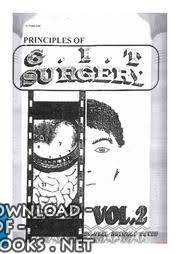📘 قراءة كتاب principles of general surgery VOL2 أونلاين


الطب
principles of general surgery VOL2
By: Dr .Wael Metwaly
2. CONTENTS DEVELOPING A SURGICAL DIAGNOSIS BASIC NECESSITIES FOR SURGERY ASEPTIC TECHNIQUE INCISIONS FLAP DESIGN Prevention of flap necrosis Prevention of flap dehiscence Prevention of flap tearing TISSUE HANDLING HEMOSTASIS Means of promoting wound hemostasis Dead space management DECONTAMINATION AND DEBRIDEMENT EDEMA CONTROL PATIENT GENERAL HEALTH AND NUTRITION
3. PRINCIPLES OF SURGERY Human tissues ,due to their innate properties ,react to injury fairly predictably. So ,with experience certain set principles are evolved for optimal healing.These are called as BASIC PRINCIPLES OF SURGERY.
4. DEVELOPING A SURGICAL DIAGNOSIS Important decisions regarding surgery are made from : Identifying signs and symptoms by 1. Complete and thorough history 2. Physical examination Radiographic findings Laboratory investigations Record keeping/data in an organized form Differential diagnosis
5. BASIC NECESSITIES FOR SURGERY 1. Adequate visibility is based on Adequate access- m o uth o p e ning , s urg ic a l e x p o s ure , re tra c tio n Adequate light Surgical field free of excess blood and other fluids. 2. Assistance
6. ASEPTIC TECHNIQUE It includes minimizing wound contamination by pathogenic microbes through: Medical asepsis Surgical asepsis
7. ASEPTIC TECHNIQUE(CONTD..) 1. 2. 3. Universal precautions are applied to prevent sepsis and efforts fall under the following headings. Instrument sterilization. Operatory disinfection. Surgical staff preparation. Hand and arm preparation. Clean technique. Sterile technique.
8. INCISIONS Incisions are necessary for many OMFS procedures. The following principles apply. Use a sharp blade of proper size . Use firm continuous strokes. Avoid cutting vital structures. Incise perpendicular to the epithelial surface. Intraoral incisions should be properly placed.
9. FLAP DESIGN 1. 2. 3. Principles of flap design help to prevent: Flap necrosis. Flap dehiscence Flap tearing.
10. 1.Preventing flap necrosis 1. 2. 3. 4. The tip should never be wider than the base unless a major artery is present at the base. The length of a flap should be no more than twice the width. In the oral cavity, the length should never exceed the width. When possible, include an axial blood supply in the base
Emphasizing both the science and craft of surgery, Fischer’s Mastery of Surgery, Sixth Edition, embraces a scope consistent with the broad training of a general surgeon, providing extensive coverage of vascular surgery as well as of common thoracic, breast, esophageal, endocrine, colorectal, gastric, pancreatic, liver, and biliary procedures. Organized for ease of use, each procedural chapter reviews the essentials of diagnosis, anatomy, and pre-operative planning, but focuses most heavily on step-by-step depictions and descriptions of procedures. Each chapter concludes, as is traditional for this classic text, with an editorial commentary that puts the chapter material in a broad context and provides helpful critiques of the most recent literature.
The path to surgical mastery begins here!
* Step-by-step guidance takes readers through each procedure, with tips and cautions from leading surgeons.
* More than 3,400 illustrations offer a surgeon’s-eye-view of the most advanced approaches.
*Over 450 renowned contributors share their surgical expertise with readers.
* Focus on evidence-based surgery reveals the science behind each approach.
* A companion website includes the fully searchable text and exclusive web-only chapters not found in the text.
NEW in the Sixth Edition…
* Over a dozen new chapters address endovascular treatment of varicose veins, fasciotomy, minimally invasive parathyroidectomy, reconstruction of the chest wall, thoracic aortic transaction, vascular injury to extremities.
*Fully updated material details the latest developments in vascular procedures, including both open and endovascular procedures.
* New full-color design throughout the text, including many new color images, help readers visualize and remember key anatomic features and surgical techniques
سنة النشر : 2017م / 1438هـ .
حجم الكتاب عند التحميل : 43.6 ميجا بايت .
نوع الكتاب : pdf.
عداد القراءة:
اذا اعجبك الكتاب فضلاً اضغط على أعجبني و يمكنك تحميله من هنا:

شكرًا لمساهمتكم
شكراً لمساهمتكم معنا في الإرتقاء بمستوى المكتبة ، يمكنكم االتبليغ عن اخطاء او سوء اختيار للكتب وتصنيفها ومحتواها ، أو كتاب يُمنع نشره ، او محمي بحقوق طبع ونشر ، فضلاً قم بالتبليغ عن الكتاب المُخالف:
 قبل تحميل الكتاب ..
قبل تحميل الكتاب ..
يجب ان يتوفر لديكم برنامج تشغيل وقراءة ملفات pdf
يمكن تحميلة من هنا 'http://get.adobe.com/reader/'


 منصّة المكتبة
منصّة المكتبة 